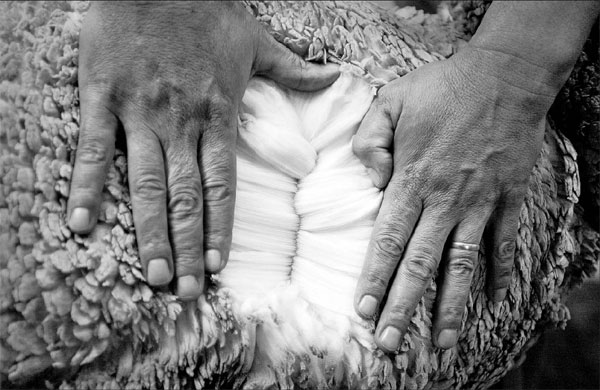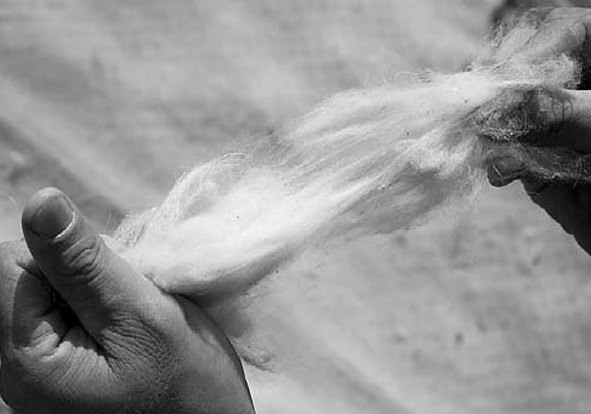Stealth wealth fabrics
Updated: 2013-08-18 07:52
By Kitty Go(China Daily)
|
|||||||
|
Merino, one of the finest types of wool fiber, comes from the sheep bred mainly in Australia and New Zealand. The breed originally comes from Spain. Photos provided to China Daily |
|
Baby cashmere comes from the fine hair of 3-month to 1-year-old Hycrus kid goats. The hair is gently combed out, not sheared. |
|
Each strand of baby cashmere is 13-13.5 microns fine compared to adult cashmere (14.5-15.5 microns) and human hair (50 microns). |
|
Superfine merino wool is the finest and most expensive suiting fabric in the market, even finer than cashmere. |
Cashmeres and the finest wools let you revel in your own luxury privately. Kitty Go seeks out the select fibers.
For most enthusiastic Chinese shoppers who line up patiently outside luxury-goods boutiques in fashion capitals, designer-logoed handbags, shoes, visible accessories and even clothing recognizable by style are trophy purchases. But as any society develops in wealth and education, there will be those who will want to stand out without screaming. Others have tastes that will evolve from just being in fashion to being fashionable, perhaps to the point of achieving an elusive "subtle elegance" from being "in the know".
One of the most discreet ways of enjoying clothing without declaring your obvious wealth and taste is also the most tactile. Think of the softness of unlined cashmere against your skin or the drape of superfine merino wool that flows with your every movement.
No one but you will know how much care, pride and heritage has gone into the production of a garment. No one but you will know how great it feels to wear something that only a discerning few can afford and most of all, appreciate.
Luxury fabrics like cashmere and superfine merino wool are expensive because their resources, like pastures and breeders, are rare and their production is time-consuming, labor-intensive and involves extensive research and development. For example, it takes many years of cross-breeding in different climactic conditions with varying diets to arrive at a breed of merino sheep that can produce the finest wool. It takes many years of business relationships and trust to convince cashmere breeders to cooperate in the sourcing of "baby" cashmere.
These fabrics comprise the perfect travel wardrobe because at the highest quality, they are practical by being wrinkle-free and suited to most climates.
Cashmere and baby cashmere
Cashmere gets its name from a breed of goats called Kashmir. The breed got its name from Kashmir, currently a disputed region at India's border, where the fiber was originally processed and traded as early as the 1500s until the 1900s.
Ancient royalty and courts used these shawls in political and religious events and as diplomatic gifts. In the late 18th century, these shawls were brought from India to Britain where they became popular with the upper class for its light weight and warmth. Micron for micron, top quality cashmere is warmer than sheep's wool.
About two goats are needed to make a medium-weight two-ply cashmere sweater available at retail from $200 to over $700. (Ply refers to the strands that are twisted together to make yarn.) Only 6,500 tons of cashmere are produced every year compared to wool, which runs to 2 million tons.
Cashmere is also one of the finest fibers. Each hair measures 13-16 microns while ordinary wool measures 22-25 microns. Compare that with human hair at 50-60 microns. (1 micron = 1/1000 mm)
Unlike sheep, which are simply sheared, the fur of Kashmir goats has to be sorted by separating the soft undercoat (the fibers used to make sweaters) from the rest of the wool. This is the beginning of a challenging process where people have to see, feel and single out the softest wool by hand.
China is the largest supplier of cashmere, but the finest wool comes from goats herded in Mongolia where winters are harsher.
The spinning and weaving process also contributes to the cost of a product. Uncompromising labels such as Loro Piana and Berluti buy the best cashmere from Mongolia but spin and weave the yarns and then sew the garments in Europe, usually in Italy.
Loro Piana has made its reputation as the "go-to" brand for the best cashmere in the world, while Berluti, known for its men's shoes, recently introduced a luxurious ready-to-wear line for men featuring unlined cashmere pieces in tightly woven yet extremely light double-ply cashmere. French label Eric Bompard makes only cashmere products that are mostly manufactured in China. They are of relatively good quality and this has helped build the label's reputation as one that has value for money for cashmere items ranging from tops to trousers (even slippers) ranging from single-ply (perfect for temperate summer evenings) to heavier four-ply knits.
Cashmere may be a luxury but 'baby' cashmere takes softness and fineness to another level. Possibly the only brand that retails 'baby' cashmere pieces is Loro Piana.
After many years of cooperation, the company convinced its nomadic Chinese cashmere suppliers to sell baby cashmere fibers exclusively to them. Hairs on 3- to 12-month-old kid goats are gently combed out (not shaved).
As it is, Loro Piana's best "adult cashmere" has a fineness of 14.5-15.5 microns. Baby cashmere is about 13-13.5 microns and is produced under the same laborious and exacting conditions as "adult cashmere".
Because of its size, each kid produces only 80 grams of fiber per year compared to the 120-150 grams produced by an adult goat.
Loro Piana's baby cashmere products are identified by a special woven brown label with gold inscription. Scarves are distinguished by a colored selvage, a line of contrasting colored thread running along one edge.
Superfine merino wool
Merino wool comes from the eponymous sheep, which are now primarily found in Australia and New Zealand. This breed originates from the Spain and was introduced to Australia by European settlers over 200 years ago.
Superfine merino wool is the finest and most expensive wool in the market today. Fine merino wool, used by some designer and luxury brands, is 18.6-20 microns. But superfine merino wool measuring less than 18.5 microns in diameter makes up only 20 percent of the total wool market.
Its rarity and cost allows it to be used and produced only for the best (mostly menswear) brands in the market such as Brioni, Ermenegildo Zegna, Loro Piana, Kiton and Canali who usually use the woven fabrics for expensive suits and jackets that retail from $3,000-35,000.
Producers and users of superfine merino wool claim that the fabric drapes well, is virtually wrinkle-free, lightweight and is perfect for any weather, including humid summers. Zegna has two popular fabrics, the Trofeo which is 18.5 microns and 15 Milmil 15 which is (naturally) 15 microns.
However, the ultimate superfine merino wool is sold only by Loro Piana and measures 11.1 microns, finer than "baby" cashmere or silk, which is 10-12 microns.
"If we broke 11 (microns), anything is possible in the future," says CEO Per Luigi Loro Piana at the worldwide official awards night in Hong Kong.
As a rule, the company does not spin and weave this "record bale" until they find another bale finer than this in the future. In that way, this fiber is treated and hedged like vintage wine.
The total production of every record bale is only about 150 meters. This limited yardage allows for only 40 custom-made suits at about $35,000. When it comes to luxury fabrics at this level, it would be hard to pull the wool over a connoisseur's trained eye.
Contact the writer at sundayed@chinadaily.com.cn.
(China Daily 08/18/2013 page13)



